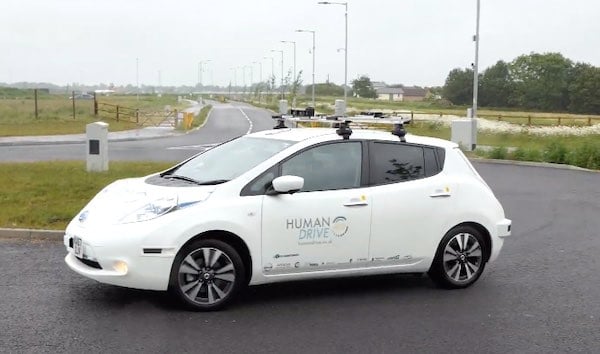Setting a new record journey for autonomous cars, a modified version of the all-electric Nissan LEAF drove itself across 230 miles in the UK after years of research and development. This is the UK’s longest autonomous car journey, which originated in Bedfordshire at Nissan’s European technical centre and ended at Nissan’s manufacturing plant in Sunderland.
Setting a new record journey for autonomous cars, a modified version of the all-electric Nissan LEAF drove itself across 230 miles in the UK after years of research and development. This is the UK’s longest autonomous car journey, which originated in Bedfordshire at Nissan’s European technical centre and ended at Nissan’s manufacturing plant in Sunderland.

The Nissan Leaf used to make the 230 mile journey across the UK set a new record for autonomous vehicles by successfully facing and overcoming typical challenges for AVs. Image Credit: Human Drive.
A Smooth and Bump-Free Trip
According to Nissan, the journey went ahead without much human intervention; the only time that a human driver had to regain control of the vehicle during the course of the journey was when the vehicle had to pull into motorway service stations to be charged.
During its journey, the vehicle had to navigate complex roundabouts, high-speed country lanes with no road markings, contraflow systems, and often used roads with faded markings and no kerbs—road types that autonomous vehicles often struggle to handle.
To complete its journey, the all-electric vehicle relied on eight LIDARs, seven cameras, an advanced GPS system, and advanced sensors equipped throughout the vehicle. This technology handled lane changing, merging, turning, stopping, and starting when necessary.
Nissan’s European senior vice president for research and development, David Moss, stated, “The vehicle is much more aware of what is happening in that surrounding area than possibly a driver would be because of the amount of sensors which are continually monitoring the environment. Other drivers around the vehicle would not have noticed that the vehicle is actually fully autonomous.”
Understandably, the Nissan LEAF team view this journey as a major success and milestone in its efforts to bring commercial autonomous vehicles to market and make them feel more “human-like and natural”.

The UK's HumanDrive project was established with the intention to develop an AV prototype that could demonstrate a lengthy end-to-end journey in a variety of settings. Image Credit: HumanDrive.
The Next Step for Self-Driving Vehicles in the UK
The journey itself was government-funded, forming part of the £13.5 million HumanDrive project, a consortium of public and private technology companies with the goal of testing the limits of autonomous driving.
The UK’s Business Minister Nadhim Zahawi said, “Safely completing the longest autonomous drive in Britain is an incredible achievement for Nissan and the HumanDrive consortium and a huge step towards the rollout of driverless cars on UK streets. This project is a shining example of how the automotive industry, working with government, can drive forward technology to benefit people’s mobility – while helping to slash carbon emissions.”
Despite the Nissan LEAF’s successful journey, it will likely be several years before even the most robust self-driving technologies and electric vehicles are ready for commercialization.
Nissan started testing its self-driving LEAF vehicles in 2013 and deployed self-driving test vehicles in Europe in 2017. In 2019, the Nissan LEAF was the world’s third most popular electric vehicle.





